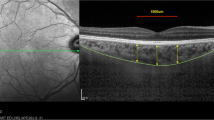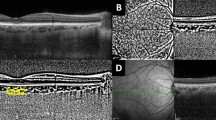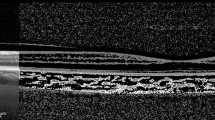Abstract
Background
The aim of this study was to evaluate the relationship between the choroidal structure of diabetic patients without diabetic retinopathy (DR) and duration of diabetes.
Methods
This study is a retrospective observational study in diabetic patients without DR. Eyes with diabetes mellitus (DM) (n = 105) were divided into two groups based on the duration: long duration group (over 10 years, n = 31) and short duration group (less than 10 years, n = 74). One hundred seventeen eyes of non-diabetic patients were used as control group. All patients underwent enhanced depth imaging optical coherence tomography, and the choroidal structure was analyzed using a binarization method.
Results
There was no significant difference in areas of total choroid and lumina/stroma or central choroidal thickness (CCT) between control and DM groups. In contrast, lumina/total choroidal (L/C) ratio was significantly lower in diabetic eyes than in control eyes (P = 0.02). Although there was no significant difference in the areas or CCT between short and long duration groups, L/C ratio was significantly lower in the long duration group than in the short duration group (P = 0.03).
Conclusions
The current study suggests that choroidal vasculature is involved in the diabetic eyes and that the choroidal structure has changed with duration of diabetes. Our study points out that L/C ratio is a new potential biomarker in monitoring choroidal vascular disorders in diabetic eyes without DR.



Similar content being viewed by others
References
Rathmann W, Giani G (2004) Global prevalence of diabetes: estimates for the year 2000 and projections for 2030. Diabetes Care 27:2568–2569 author reply 2569
Yau JWY, Rogers SL, Kawasaki R et al (2012) Global prevalence and major risk factors of diabetic retinopathy. Diabetes Care 35:556–564. https://doi.org/10.2337/dc11-1909
Antonetti DA, Klein R, Gardner TW (2012) Diabetic retinopathy. N Engl J Med 366:1227–1239. https://doi.org/10.1056/NEJMra1005073
Durham JT, Herman IM (2011) Microvascular modifications in diabetic retinopathy. Curr Diab Rep 11:253–264. https://doi.org/10.1007/s11892-011-0204-0
Barot M, Gokulgandhi MR, Patel S, Mitra AK (2013) Microvascular complications and diabetic retinopathy: recent advances and future implications. Future Med Chem 5:301–314. https://doi.org/10.4155/fmc.12.206
Hidayat AA, Fine BS (1985) Diabetic choroidopathy. Light and electron microscopic observations of seven cases. Ophthalmology 92:512–522
Lutty GA (2017) Diabetic choroidopathy. Vis Res 139:161–167. https://doi.org/10.1016/j.visres.2017.04.011
Laviers H, Zambarakji H (2014) Enhanced depth imaging-OCT of the choroid: a review of the current literature. Graefes Arch Clin Exp Ophthalmol 252:1871–1883. https://doi.org/10.1007/s00417-014-2840-y
Kase S, Endo H, Yokoi M et al (2016) Choroidal thickness in diabetic retinopathy in relation to long-term systemic treatments for diabetes mellitus. Eur J Ophthalmol 26:158–162. https://doi.org/10.5301/ejo.5000676
Endo H, Kase S, Takahashi M et al (2018) Alteration of layer thickness in the choroid of diabetic patients. Clin Exp Ophthalmol 46:926–933. https://doi.org/10.1111/ceo.13299
Sonoda S, Sakamoto T, Yamashita T et al (2014) Effect of intravitreal triamcinolone acetonide or bevacizumab on choroidal thickness in eyes with diabetic macular edema. Invest Ophthalmol Vis Sci 55:3979. https://doi.org/10.1167/iovs.14-14188
Okamoto M, Yamashita M, Ogata N (2018) Effects of intravitreal injection of ranibizumab on choroidal structure and blood flow in eyes with diabetic macular edema. Graefes Arch Clin Exp Ophthalmol 256:885–892. https://doi.org/10.1007/s00417-018-3939-3
Tan K-A, Laude A, Yip V et al (2016) Choroidal vascularity index—a novel optical coherence tomography parameter for disease monitoring in diabetes mellitus? Acta Ophthalmol 94:e612–e616. https://doi.org/10.1111/aos.13044
Gupta P, Thakku SG, Sabanayagam C et al (2017) Characterisation of choroidal morphological and vascular features in diabetes and diabetic retinopathy. Br J Ophthalmol 101:1038–1044. https://doi.org/10.1136/bjophthalmol-2016-309366
Kim M, Ha MJ, Choi SY, Park Y-H (2018) Choroidal vascularity index in type-2 diabetes analyzed by swept-source optical coherence tomography. Sci Rep 8:70. https://doi.org/10.1038/s41598-017-18511-7
Klein R, Klein BE, Moss SE et al (1984) The Wisconsin epidemiologic study of diabetic retinopathy. II. Prevalence and risk of diabetic retinopathy when age at diagnosis is less than 30 years. Arch Ophthalmol 102:520–526
Horváth H, Kovács I, Sándor GL et al (2018) Choroidal thickness changes in non-treated eyes of patients with diabetes: swept-source optical coherence tomography study. Acta Diabetol 55:927–934. https://doi.org/10.1007/s00592-018-1169-0
Yülek F, Uğurlu N, Önal ED et al (2014) Choroidal changes and duration of diabetes. Semin Ophthalmol 29:80–84. https://doi.org/10.3109/08820538.2013.821504
Sudhalkar A, Chhablani JK, Venkata A et al (2015) Choroidal thickness in diabetic patients of Indian ethnicity. Indian J Ophthalmol 63:912–916. https://doi.org/10.4103/0301-4738.176024
Abadia B, Suñen I, Calvo P et al (2018) Choroidal thickness measured using swept-source optical coherence tomography is reduced in patients with type 2 diabetes. PLoS One 13:e0191977. https://doi.org/10.1371/journal.pone.0191977
Tavares Ferreira J, Vicente A, Proença R et al (2018) Choroidal thickness in diabetic patients without diabetic retinopathy. Retina 38:795–804. https://doi.org/10.1097/IAE.0000000000001582
Kawasaki R, Tanaka S, Tanaka S et al (2011) Incidence and progression of diabetic retinopathy in Japanese adults with type 2 diabetes: 8 year follow-up study of the Japan Diabetes Complications Study (JDCS). Diabetologia 54:2288–2294. https://doi.org/10.1007/s00125-011-2199-0
Sonoda S, Sakamoto T, Kakiuchi N et al (2018) Semi-automated software to measure luminal and stromal areas of choroid in optical coherence tomographic images. Jpn J Ophthalmol 62:179–185. https://doi.org/10.1007/s10384-017-0558-1
Sonoda S, Sakamoto T, Yamashita T et al (2015) Luminal and stromal areas of choroid determined by binarization method of optical coherence tomographic images. Am J Ophthalmol 159:1123–1131.e1. https://doi.org/10.1016/j.ajo.2015.03.005
Nagaoka T, Kitaya N, Sugawara R et al (2004) Alteration of choroidal circulation in the foveal region in patients with type 2 diabetes. Br J Ophthalmol 88:1060–1063. https://doi.org/10.1136/bjo.2003.035345
Bursell SE, Clermont AC, Kinsley BT et al (1996) Retinal blood flow changes in patients with insulin-dependent diabetes mellitus and no diabetic retinopathy. Invest Ophthalmol Vis Sci 37:886–897
McLeod DS, Lefer DJ, Merges C, Lutty GA (1995) Enhanced expression of intracellular adhesion molecule-1 and P-selectin in the diabetic human retina and choroid. Am J Pathol 147:642–653
Esmaeelpour M, Považay B, Hermann B et al (2011) Mapping choroidal and retinal thickness variation in type 2 diabetes using three-dimensional 1060-nm optical coherence tomography. Invest Ophthalmol Vis Sci 52:5311–5316. https://doi.org/10.1167/iovs.10-6875
Querques G, Lattanzio R, Querques L et al (2012) Enhanced depth imaging optical coherence tomography in type 2 diabetes. Invest Opthalmol Vis Sci 53:6017. https://doi.org/10.1167/iovs.12-9692
Dimitrova G, Chihara E, Takahashi H et al (2017) Quantitative retinal optical coherence tomography angiography in patients with diabetes without diabetic retinopathy. Invest Ophthalmol Vis Sci 58:190–196. https://doi.org/10.1167/iovs.16-20531
Scarinci F, Picconi F, Giorno P et al (2018) Deep capillary plexus impairment in patients with type 1 diabetes mellitus with no signs of diabetic retinopathy revealed using optical coherence tomography angiography. Acta Ophthalmol 96:e264–e265. https://doi.org/10.1111/aos.13510
Simonett JM, Scarinci F, Picconi F et al (2017) Early microvascular retinal changes in optical coherence tomography angiography in patients with type 1 diabetes mellitus. Acta Ophthalmol 95:e751–e755. https://doi.org/10.1111/aos.13404
Carnevali A, Sacconi R, Corbelli E et al (2017) Optical coherence tomography angiography analysis of retinal vascular plexuses and choriocapillaris in patients with type 1 diabetes without diabetic retinopathy. Acta Diabetol 54:695–702. https://doi.org/10.1007/s00592-017-0996-8
Cao D, Yang D, Huang Z et al (2018) Optical coherence tomography angiography discerns preclinical diabetic retinopathy in eyes of patients with type 2 diabetes without clinical diabetic retinopathy. Acta Diabetol 55:469–477. https://doi.org/10.1007/s00592-018-1115-1
Sogawa K, Nagaoka T, Tanano I et al (2012) Association between diabetic retinopathy and flow-mediated vasodilation in type 2 DM. Curr Eye Res 37:446–451. https://doi.org/10.3109/02713683.2012.654883
Huang ES, Laiteerapong N, Liu JY et al (2014) Rates of complications and mortality in older patients with diabetes mellitus: the diabetes and aging study. JAMA Intern Med 174:251–258. https://doi.org/10.1001/jamainternmed.2013.12956
Goldin A, Beckman JA, Schmidt AM, Creager MA (2006) Advanced glycation end products. Circulation 114:597–605. https://doi.org/10.1161/CIRCULATIONAHA.106.621854
Boehm BO, Schilling S, Rosinger S et al (2004) Elevated serum levels of N(epsilon)-carboxymethyl-lysine, an advanced glycation end product, are associated with proliferative diabetic retinopathy and macular oedema. Diabetologia 47:1376–1379. https://doi.org/10.1007/s00125-004-1455-y
Monnier VM, Bautista O, Kenny D et al (1999) Skin collagen glycation, glycoxidation, and crosslinking are lower in subjects with long-term intensive versus conventional therapy of type 1 diabetes: relevance of glycated collagen products versus HbA1c as markers of diabetic complications. DCCT Skin Collagen Ancillary Study Group. Diabetes Control and Complications Trial. Diabetes 48:870–880
Hirano T, Iesato Y, Toriyama Y et al (2014) Correlation between diabetic retinopathy severity and elevated skin autofluorescence as a marker of advanced glycation end-product accumulation in type 2 diabetic patients. J Diabetes Complicat 28:729–734. https://doi.org/10.1016/j.jdiacomp.2014.03.003
Kase S, Ishida S, Rao NA (2011) Immunolocalization of advanced glycation end products in human diabetic eyes : an immunohistochemical study. JDM vol 1, pp 57–62. https://doi.org/10.4236/jdm.2011.13009
Milne R, Brownstein S (2013) Advanced glycation end products and diabetic retinopathy. Amino Acids 44:1397–1407. https://doi.org/10.1007/s00726-011-1071-3
Lopes-Virella MF, Hunt KJ, Baker NL et al (2011) Levels of oxidized LDL and advanced glycation end products-modified LDL in circulating immune complexes are strongly associated with increased levels of carotid intima-media thickness and its progression in type 1 diabetes. Diabetes 60:582–589. https://doi.org/10.2337/db10-0915
Jo Y, Ikuno Y, Iwamoto R et al (2014) Choroidal thickness changes after diabetes type 2 and blood pressure control in a hospitalized situation. Retina 34:1190–1198. https://doi.org/10.1097/IAE.0000000000000051
Akay F, Gundogan FC, Yolcu U et al (2016) Choroidal thickness in systemic arterial hypertension. Eur J Ophthalmol 26:152–157. https://doi.org/10.5301/ejo.5000675
Martin LM, Leff M, Calonge N et al (2000) Validation of self-reported chronic conditions and health services in a managed care population. Am J Prev Med 18:215–218
Shah BR, Manuel DG (2008) Self-reported diabetes is associated with self-management behaviour: a cohort study. BMC Health Serv Res 8:142. https://doi.org/10.1186/1472-6963-8-142
Liu G, Xu D, Wang F (2018) New insights into diabetic retinopathy by OCT angiography. Diabetes Res Clin Pract 142:243–253. https://doi.org/10.1016/j.diabres.2018.05.043
Acknowledgements
The authors thank Dr. Michiyuki Saito for his technical assistance in evaluation of the manuscript.
Funding
No funding was received for this research.
Author information
Authors and Affiliations
Corresponding author
Ethics declarations
For this type of study, formal consent is not required.
Conflict of interest
The authors declare that they have no conflict of interest.
Additional information
Publisher’s note
Springer Nature remains neutral with regard to jurisdictional claims in published maps and institutional affiliations.
Rights and permissions
About this article
Cite this article
Endo, H., Kase, S., Ito, Y. et al. Relationship between choroidal structure and duration of diabetes. Graefes Arch Clin Exp Ophthalmol 257, 1133–1140 (2019). https://doi.org/10.1007/s00417-019-04295-1
Received:
Revised:
Accepted:
Published:
Issue Date:
DOI: https://doi.org/10.1007/s00417-019-04295-1




